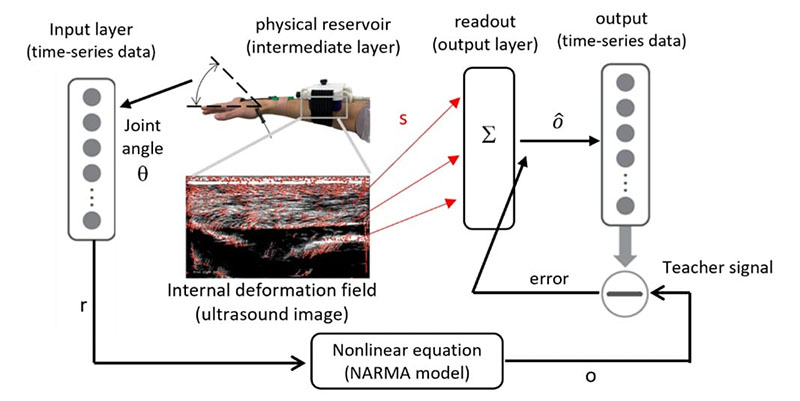Research Progress
Humans as hardware: computing with biological tissue
Post: 2025-04-08 08:57 View:830
| Most computers run on microchips, but what if we’ve been overlooking a simpler, more elegant computational tool all this time? In fact, what if we were the computational tool? |
| As crazy as it sounds, a future in which humans are the ones doing the computing may be closer than we think. In an article published in IEEE Access ("Information processing via human soft tissue: Soft tissue reservoir computing"), Yo Kobayashi from the Graduate School of Engineering Science at The University of Osaka demonstrates that living tissue can be used to process information and solve complex equations, exactly as a computer does. |
 |
| Information processing via human soft tissue. (Image: Yo Kobayashi) |
| This groundbreaking achievement is an example of the power of the computational framework known as reservoir computing, in which data are input into a complex “reservoir” that has the ability to encode rich patterns. A computational model then learns to convert these patterns into meaningful outputs via a neural network. |
| “Common reservoirs include nonlinear dynamical systems like electrical circuits or tanks of fluid,” says Kobayashi. “There are comparatively few studies that use living organisms as reservoirs, and until now, none that use in vivo human tissue.” |
| To test if human tissue could be used to perform computations, Kobayashi had participants supply biomechanical data by bending their wrists at various angles and taking ultrasound images of the subsequent muscle deformation in their arms. These data were then used to create a “biophysical reservoir” for data processing. |
| “An ideal reservoir possesses both complexity and memory,” explains Kobayashi. “Since the mechanical responses of soft tissue inherently demonstrate stress–strain nonlinearity and viscoelasticity, muscular tissue easily satisfies these criteria.” |
| In a series of benchmark tests involving solving complicated nonlinear equations, Kobayashi compared the performance of his human tissue model with that of standard linear regression. He found that the model using the biophysical reservoir was consistently more accurate by an order of magnitude. |
| “One potential application area of this technology is wearable devices,” says Kobayashi. “In the future, it may be possible to use our own tissue as a convenient computational resource. Since soft tissue is present throughout the body, a wearable device could delegate calculations to the tissue, enhancing performance.” |
| Now that the principle has been demonstrated, Kobayashi is focusing on scaling up his model to handle more demanding computations, as well as investigating the capacity of other biomaterials to be used as reservoirs. If his research continues to bear fruit, it may not be long before machine learning is overtaken by organic learning. |
Address: C508 Dingxin Building, Jilin University, 2699 Qianjin Street, Changchun 130012, P. R. China
Copyright © 2025 International Society of Bionic Engineering All Rights Reserved
吉ICP备11002416号-1
Copyright © 2025 International Society of Bionic Engineering All Rights Reserved
吉ICP备11002416号-1









